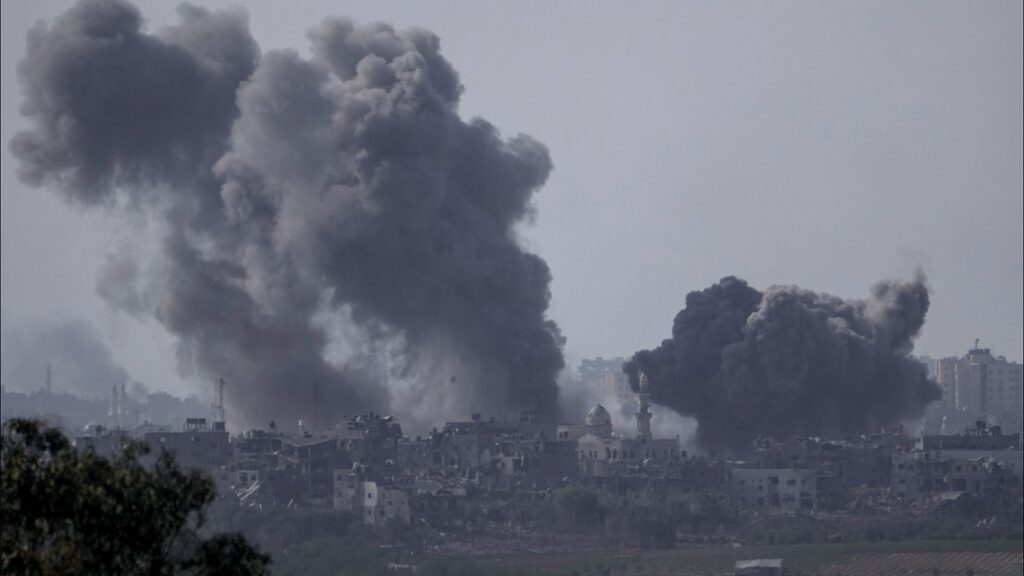
Water has run out at U.N. shelters across Gaza as thousands packed into the courtyard of the besieged territory’s largest hospital as a refuge of last resort from a looming Israeli ground offensive and overwhelmed doctors struggled to care for patients they fear will die once generators run out of fuel.
Palestinian civilians across Gaza, already battered by years of conflict, were struggling for survival Sunday in the face of an unprecedented Israeli operation against the territory following a Hamas militant attack on Oct. 7 that killed 1,300 Israelis, most of them civilians.
Israel has cut off the flow of food, medicine, water and electricity to Gaza, pounded neighborhoods with airstrikes and told the estimated 1 million residents of the north to flee south ahead of Israel’s planned attack. The Gaza Health Ministry said more than 2,300 Palestinians have been killed since the fighting erupted last weekend.
U.S. national security adviser Jake Sullivan told CNN on Sunday that Israeli officials told him they had turned the water back on in southern Gaza. But the spokesman for Israel’s energy and water ministry, Adir Dahan, said it was only flowing at a single location in southern Gaza. Aid workers in Gaza said they had not yet seen evidence the water was back and a Gaza government spokesperson said it was not flowing.
Throughout the day, Gazans lined up for hours outside bakeries and jostled to buy bread, as fears of food shortages loomed. Umm Abdullah Abu Rizq had come at 7 a.m. hoping to buy food to feed her family and the others sheltering in her home.
In Khan Younis, residents rushed to mosques where clean water supplies were still available, for now. Eyad Aqel, a resident, said widespread electricity outages meant water could not be pumped up to replenish his tank. He held a small plastic water container he said would be his family’s supply for washing and cooking.
Relief groups called for the protection of the over 2 million civilians in Gaza urging an emergency corridor be established for the transfer of humanitarian aid. There was no indication that such a corridor will be opened anytime soon, said Ahmed al-Mandhari, the regional director of the World Health Organization.
The agency has supplies over the Rafah border in Egypt, but no permission from either Egypt or Israel to deliver them.
“The difference with this escalation is we don’t have medical aid coming in from outside, the border is closed, electricity is off and this constitutes a high danger for our patients,” said Dr. Mohammed Qandeel, who works at Nasser Hospital in the southern Khan Younis area.
Doctors in the evacuation zone said they couldn’t relocate their patients safely, so they decided to stay as well to care for them.
“We shall not evacuate the hospital even if it costs us our lives,” said Dr. Hussam Abu Safiya, the head of pediatrics at Kamal Adwan Hospital in Beit Lahia.
If they left, the seven newborns in the intensive care unit would die, he said. And even if they could move them, there is nowhere for them to go in the 40-kilometer-long (25-mile-long) coastal territory. “Hospitals are full,” Abu Safiya said. The wounded stream in every day with severed limbs and life-threatening injuries, he said.
Following the evacuation order, around 22 hospitals with 2,000 patients in northern Gaza managed to move “mobile patients” south, said al-Mandhari. But most can’t be evacuated, he said. Over 60% of hospital beds in the strip are located in northern Gaza, he said.
Other doctors feared for the lives of patients dependent on ventilators and those suffering from complex blast wounds needing around-the-clock care. Doctors worried entire hospital facilities would be shut down and many would die as the last of fuel stocks powering their generators came close to running out. United Nations humanitarian monitors estimated this could happen by Monday.
At Shifa Hospital in Gaza City, the heart of the evacuation zone, medical officials estimated at least 35,000 men, women and children crammed into the large open grounds, in the stairways and corridors of the hospital building, hoping the location would give them protection from the fighting. “Their situation is very difficult,” said hospital director Mohammed Abu Selmia.
Still, hundreds of wounded continue to come to the hospital every day, he said.
The violence has not spared the health workers. Plastic surgeon Medhat Saidam was killed along with 30 members of his family in an airstrike Saturday when he returned home from work, said Ghassan Abu Sittah, a doctor at Shifa. At least three Shifa doctors and 15 medics were killed so far, Selmia said.
Gaza’s Health Ministry issued an urgent appeal to the international community to send replacement medical workers.
About half a million Gaza residents have taken refuge in U.N. shelters across the territory and are running out of water, said Juliette Touma, a spokesperson for the U.N.’s Palestinian refugee agency, known by the acronym UNRWA. “Gaza is running dry,” she said, adding that U.N. teams have also begun to ration water.
Touma said a quarter of a million people in Gaza moved to shelters over the past 24 hours, the majority of which are U.N. schools where “clean water has actually run out,” said Inas Hamdan, another UNRWA spokeswoman.
Across Gaza, families rationed dwindling water supplies, with many forced to drink dirty or brackish water. Many resorted to going to dirty wells and the sea, increasing the risk of dehydration, water borne diseases and more deaths.
“I am very happy that I was able to brush my teeth today, can you imagine what lengths we have reached?” said Shaima al-Farra, in Khan Younis.
___
Kullab reported from Baghdad. Associated Press writer Sam Magdy contributed from Cairo.




